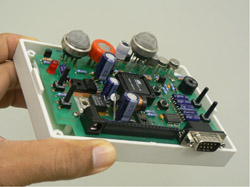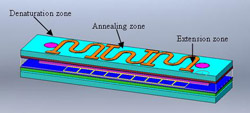Ongoing Projects
Research and Development of Cantilever based Biosensor: Sensor arrays developed from MEMS for chemical measurement have gained more attention from researchers around the world. However, there has not been any leader in this sensor array technology. It is an excellent opportunity for Thai researchers to develop a sensor array chip, apply it to the national major industries such as agriculture and food technology, and become the leader in these fields. There are three key techniques in the development of sensor array chip: gas sensing, biosensing, and multiple molecular sensing. Gas sensor detects chemical in gaseous state. Biosensor distinguishes specific microorganism. Multiple molecular sensors use a sensing agent that can detect various types of chemical based on different responses that occur. The sensing mechanism is based on the learning process of human’s olfaction. The development of sensor array chip integrates the knowledge in several fields, including synthetic chemistry, analytical chemistry, physics, surface engineering, electrical engineering, and computer engineering. Therefore it is a collaborative project among NSTDA researchers and experts from other institutes.
Printed Electronics: Microsystem technology on silicon yet high cost , complicated and time-consuming has been widely standard for integrated circuit and sensor fabrication . Printed electronic is becoming an alternative technology for simple , extremely low cost and less time-consuming for integrated circuit and sensor fabrication. Our interests encompass synthesis of newly polymeric and conductive semiconductor , fabricating biosensors, agricultural sens! ors, tra nsducers, integrated circuits and MEMS using new techniques such as inkjet printing and self-assembly printing. Currently we are working on inkjet printed saliva glucose sensor, self-assembly carbon nanotube printing for self assemble nanotransistor and biosensor applications and inkjet printing guided electrospinning technology.
Carbon Nanotube (CNT) based Gas Sensor: The aim of this project is to develop of high-sensitivity micro gas sensor utilizing nanotechnology. In this project, fabrication facility including chemical vapor deposition system (CVD) for carbon nanotube and other nanostructures will be constructed. CNTs will be then synthesized in various forms. Next, CNTs based gas sensor including CNT-metal oxide and CNT-polymer composite will be fabricated. The CNTs based gas sensors will be characterized toward different gases such as methane and alcohol. These sensors are expected to exhibit high sensitivity with lower operating temperature desirable for various gas sensing applications. In the future, the production cost of these sensors will be minimized for commercialization.

Research and Development of Electronic Olfactory Sensing System by Sensor Array Technology: The objective of this R&D project is to enhance the capability to manufacture gas micro sensors using combined sensor technologies. The main application is an odor sensor to be utilized in an electronic olfactory sensing system which is applicable to food industries, health control, or environment monitor. For food industries, an odor sensor can be used to indicate the quality of the product whether the food is fresh or rotten. In health control, an odor sensor can detect the alcohol level at higher a! ccuracy than the conventional alcohol detector. An assembled sensitive sensor device can be built from an array of odor sensors. Our priority task in this project is to develop a sensitive sensor system prototype for quality control in local food industry.

Research and Development of Lab-on-a-Chip: This project aims to build a lab-on-a-chip from polymer-based materials such as Polydimethylsiloxane (PDMS). A diagnostic kit can be constructed by applying MEMS and microfluidic technology. First, the chip pattern is designed and printed on a master by photolithography method. This master is used as a micro mold to cast a polymer chip via thermal polymerization. Then the patterned PDMS is bonded to a glass or polymer substrate. Finally, the lab-on-a-chip with specific microchannel is obtained. This lab-on-a-chip serves as a low cost micro-scale experiment. Examples of lab-on-a-chip are Capillary Electrophoresis Chip and DNA Diagnostic Chip.

Flow injection based microfluidic device with carbon nanotube electrode for rapid salbutamol detection: A microfabicated flow injection device has been de! veloped for in-channel electrochemical detection (ECD) of a β-agonist, namely salbutamol. The microfluidic system consists of PDMS (polydimethylsiloxane) microchannel and electrochemical electrodes formed on glass substrate. The carbon nanotube (CNT) on gold layer as working electrode, silver as reference electrode and platinum as auxiliary electrode were deposited on a glass substrate. Silver, platinum, gold and stainless steel catalyst layers were coated by DC-sputtering. CNTs were then grown on the glass substance by thermal chemical vapor deposition (CVD) with gravity effect and water-assisted etching. PDMS microchannels fabricated by SU-8 molding and casting were then bonded on glass substrate by oxygen plasma treatment. Flow injection and ECD of salbutamol was performed with the amperometric detection mode for in-channel detection of salbutamol. The influences of flow rate, injection volume, and detection potential on the response of current signal were optimized. Analytical characteristics, such as sensitivity, repeatability and dynamic range have been evaluated. Fast and highly sensitive detection of salbutamol have been achieved. Thus, the proposed combination of the efficient CNT electrode and miniaturized lab-on-a-chip is a powerful platform for β-agonists detection.

Capillary Electrophoresis Chips: Capillary electrophoresis (CE) is a powerful technique for bio-chemical analysis. The technique is designed to separate species based on their size to charge ratio. The recent development of micro-fabricated capillary electrophoresis chip (CE-chip) is very attractive due to its fast analysis, high efficiency, low reagent consumption, and portability. Therefore, microchip system offers various applications such as environmental monitoring, clinical diagnostics and food contaminating. Electrochemic! al detec tion is the most suited for miniaturization, compatible with microfabrication and offer high selectivity and sensitivity. Thus, the focus of our laboratory is application of CE-chip with carbon nanotube based electrochemical detection for separation and detection of food contaminating.

Multi-channel Detection of Loop-mediated Isothermal Amplification Reaction: The loop-mediated isothermal amplification (LAMP) is the simple and rapid method for nucleic acid amplification which is widely applied due to its capacity to amplify the large amount of target DNA at short time and constant temperature. This reaction produced pyrophosphate as by-product which formed white precipitate of magnesium pyrophosphate in solution, and then the quantitative analysis of initial template DNA was performed by measuring the turbidity of reaction solution. In this work, the laboratory-made apparatus, turbidimeter, for turbidity measurement was presented. The results shown that the apparatus was useful for turbidity measurement of LAMP reaction solution in dilution of Taura syndrome virus (TSV) and White spot syndrome virus (WSSV) in shrimp. The results were confirmed and agreed with gel electrophoresis measurement.

Research and Development of Quartz Crystal Microbalance (QCM) based Sensor: In this work, we have developed an inexpensive QCM system that utilizes low cost commercially available quartz crystal resonator. The circuits of the system are designed for be compact and portable. The QCM sensor surface was modified with different sensing materials for various applications including gas sensors and biosensors. Nanomaterials such as polymeric nanofibers, carbon nanotubes, and nanocomposites were selected and then coated on the electrode surface to sense targeted species with high sensitivity.
Research and Development of Electrowetting on Dielectric (EWOD) Device for a Droplet Based Polymerase Chain Reaction System: Polymerase Chain Reaction (PCR) technology! has bee n widely used in molecular biology, forensic analysis, evolutionary and medical diagnostic. PCR requirement for point of care application is shorten reaction time and reduces PCR reagent. If the PCR chip can be done by droplet basis, then the analysis system which minimal amount of fluid will be possible. In this work, we describe the simulation and experimental study of a parallel–plate electrowetting on dielectric (EWOD) based PCR device. The EWOD device is applied to control PCR reagent and sample for a polymerase chain reaction (PCR) system. The EWOD-based PCR system consists of serpentine-shape microheater integrated underneath to maintain temperature at each stage and microchannel. DNA was driven by moving droplet through each square electrode that maintains temperature at denaturation, annealing, and extension region. The fluid dynamics of the device have been modeled by Coventorware, a commercially available MEMS simulation software, to show temperature distribution on each electrode in order to be used as a pattern model for device fabrication.

 Research
Research